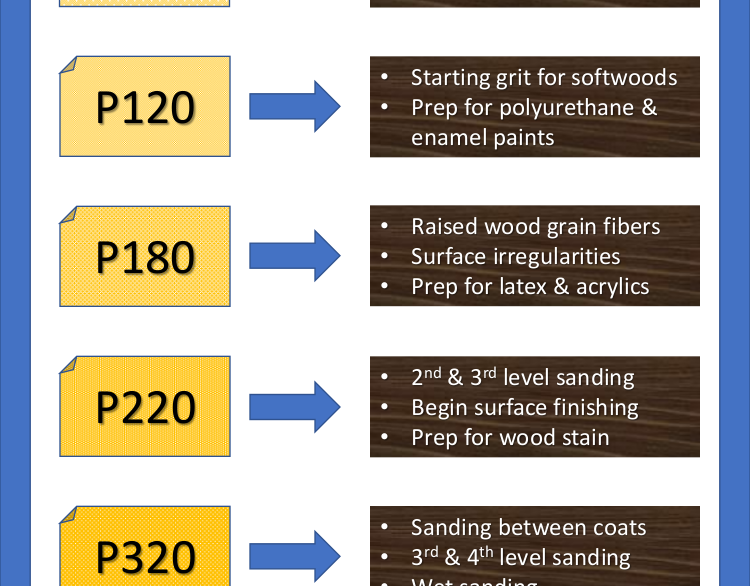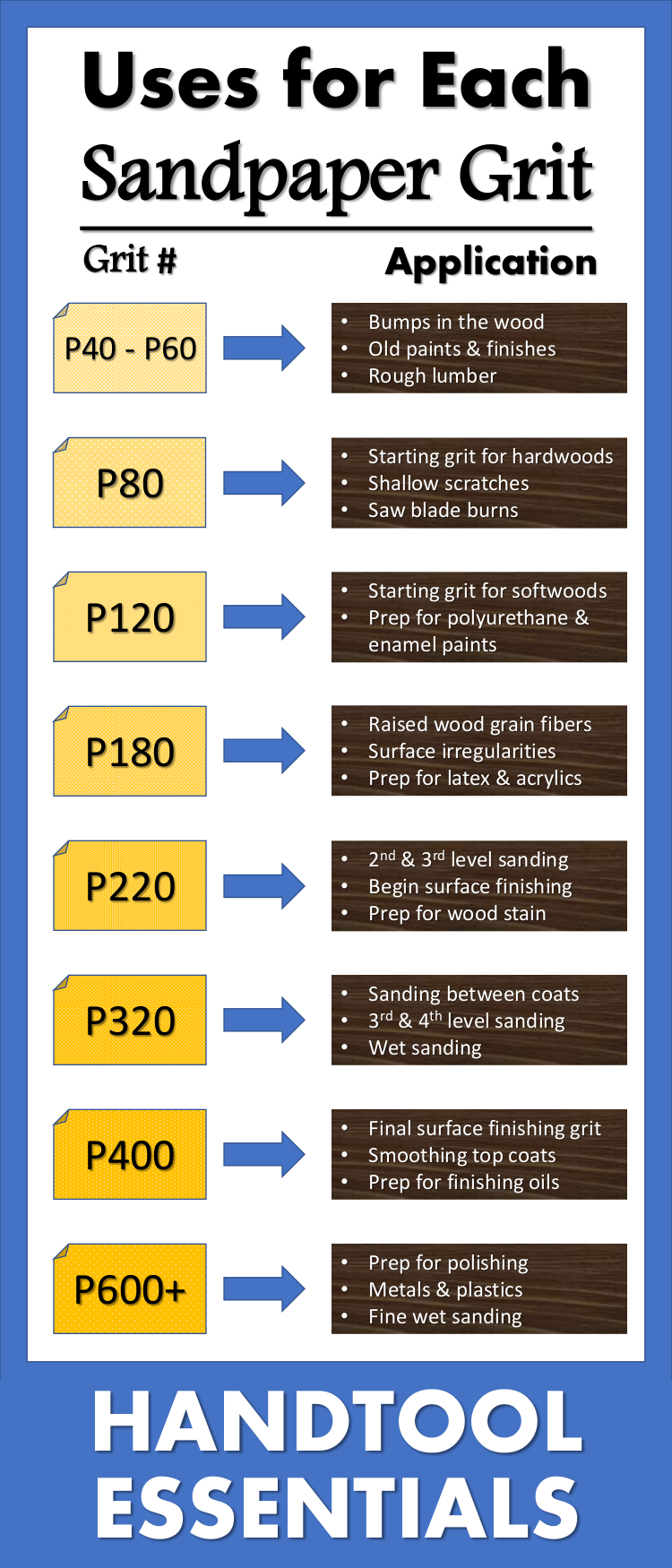Sandpaper Grit Guide For Wood

To give a clear overview of the sandpaper grit you need for your project, all options are listed below along with their application. Sanding using sandpaper is one of the most popular ways to age wood.
 7 ProApproved Tips for How to Sand Woodwork by Hand
7 ProApproved Tips for How to Sand Woodwork by Hand
The lower the number, the more coarse the grit.

Sandpaper grit guide for wood. 100 3.4 fine sandpaper no. Sandpaper grit grades and uses. 100, 150, and 220, for example.
Once you have completed smoothing the surface, you can paint it to further reduce any evidence that a repair was made. The more pressure you apply when using medium grit sandpaper, the more you will sand off. The larger the particles, the more visible the scratches they create.
Important on the last sanding belt; (reviews & buying guide 2021) your search for the best sandpaper for wood has been made easier with today’s guide. Sandpaper grit can be divided into 4 groups:
Use grit p240/280 on the last belt for best finish. It’s not suitable for removing varnish or paint from wood though. A medium sandpaper grit smooths out the wood surface enough that you don’t get “wood fuzzies” but also leaves enough “grip” in the surface of the wood so the paint sticks.
The smaller and more packed together the particles, the finer the grit. P80 grit is the best option for removing saw blade burns and deeper surface scratches. The diameter of the particles ranges between 190 to 265 micrometers.
If you don’t want as much material sanded off, apply less pressure. Sanding is not only useful but can make all the difference in a woodworking, metal or drywall project. 13 best sandpaper for wood:
60 3.3 medium sandpaper no. The grit grades below are a guide to the commonly found sandpapers available and thier uses. Good for general purpose sanding.
Using sandpaper with a grit of 180 to 220, you will need to lightly but steadily, sand down the plywood whilst all the while making sure you don’t stroke against the grain. Contents hide 1 correct sandpaper choice and grades 2 electric sanders 3 sandpaper grit numbers 3.1 hand sanding block 3.2 thick sandpaper no. Distressing painted wood is easy when you have the right tools.
Coarse, medium, fine, and extra fine. Sanding is easy to do and sandpaper in different grits is available in all hardware stores and hobby shops. Instead, you are looking to remove any scratch marks or sander swirls from the previous sanders.
Such sandpaper grit types are not suited for varnish removal or removing paint on wood. Used to flat molding of the wooden surface and the expulsion of past completions, like light layers of polyurethane. Sandpaper is graded based upon the number of abrasive particles per square inch that make up the sandpaper.
For palm sanders and detail sanders the goal isn’t fast removal of wood. They can be used in sanding unfinished wood as well as removing old varnish. Fill in any gaps after you’ve sanded, it is time to go over the wood grain to look for any gaps in the grain or voids along the edge.
The fepa standards denote such types of sandpaper grit by p60, or p80, and cami standards denote it as 80. Used for sanding of harsh wood and the expulsion of arranging blemishes on the wooden surface is regularly best finished with this sanding paper. The lower the grade, the rougher the sandpaper.
Once it has dried, you can then use a fine grit of sandpaper to smooth out the surface. The lower the number, the coarser the sandpaper as particles go up in size. In the case that you’re working with a hardwood like poplar, you can probably jump the line to p120.
220 3.6 finishing sander 3.7 sanding safety correct sandpaper choice and grades anyone who has had the […] These kinds of sandpaper grit are used to prepare wood for the finishing. Use sanding belt with grains of silicon carbide.
Here is a guide to help you distress wood with sandpaper. Because sandpaper scratches a surface to smooth it, shown below, it’s important to begin with the right grit based on the condition of the wood’s surface and whether a stain or a topcoat of finish will be applied.sandpaper can commonly be found in 80, 100, 120, 150, 180, and 220 grit. Manufacturers differ on the scale but this is the average.
This sandpaper choice is used for quick removal of material such as paint or wood and is extremely rough. For white/raw wood, do not use finer grit than p240 for the last belt, as going finer may cause issues with the wood accepting stain. Best for removing large amounts of wood and rounding off corners.
And over 100 leading sandpapers around the market, my top picks will include a variety of wood sandpaper types. At the bottom of the blog, you can download a handy guide for free that you can keep in your workshop. When determining which grit best follows the one just used, remember that the next grit should be no more than about 50 percent higher than the one before it;
Typically, the only times to start with coarser sandpaper (80 or 100 grit) are on boards with deep scratches or gouges or uneven joints after gluing. Use it for extremely rough surfaces when wood has dips, gouges. Sandpaper grit charts & guides.
Sanding can be done by hand as well as in tandem with power tools such as electric sanders to create the best finishes on these materials. Whether you have ortibal sander or the mouse sander, or even with none, i have the types. Best sandpaper for a palm sander.
 41 Genius Sanding Tips You Need to Know Sanding tips
41 Genius Sanding Tips You Need to Know Sanding tips
 41 Genius Sanding Tips You Need to Know Sanding tips
41 Genius Sanding Tips You Need to Know Sanding tips
 Pin by CK on Infographics Sandpaper, Rough wood, Diy
Pin by CK on Infographics Sandpaper, Rough wood, Diy
 How to Sand, Prep, and Stain Wood Woodworking projects
How to Sand, Prep, and Stain Wood Woodworking projects
 7 ProApproved Tips for How to Sand Woodwork by Hand (With
7 ProApproved Tips for How to Sand Woodwork by Hand (With
 Uses for Each Sandpaper Grit Woodworking, Diy
Uses for Each Sandpaper Grit Woodworking, Diy
 Woodworking Crafts *** Keep a variety of sandpaper grits
Woodworking Crafts *** Keep a variety of sandpaper grits
 How To Sand Wood Furniture 5 GameChanging Tips
How To Sand Wood Furniture 5 GameChanging Tips
 What grit sandpaper do you use between paint layers or
What grit sandpaper do you use between paint layers or
 DustFree Downdraft Sanding Table Plans Sanding Tips
DustFree Downdraft Sanding Table Plans Sanding Tips
 True Grit How to Choose Sandpaper Grit and Wood Finishes
True Grit How to Choose Sandpaper Grit and Wood Finishes
 Sandpaper Caddy Plans Sanding Wood Solutions
Sandpaper Caddy Plans Sanding Wood Solutions
 5 Top Tips For Hand Sanding The Knowledge Blog Sanding
5 Top Tips For Hand Sanding The Knowledge Blog Sanding
 How to sand wood DIY tips for woodworking Sanding wood
How to sand wood DIY tips for woodworking Sanding wood
 Wood Finishing Tips Sanding wood, Woodworking, Sanding
Wood Finishing Tips Sanding wood, Woodworking, Sanding
 Uses for Each Sandpaper Grit Chart Sandpaper Grades for
Uses for Each Sandpaper Grit Chart Sandpaper Grades for
 Your complete guide to sandpaper grits, what they mean
Your complete guide to sandpaper grits, what they mean





